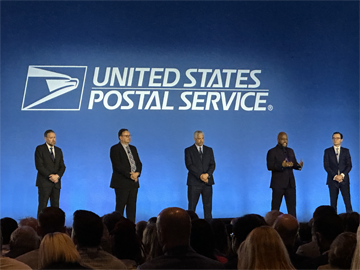Navigating USPS Modernization: What It Means for Print Mailers

This year’s USPS National Postal Forum saw its highest attendance in 15 years and the most exhibitors in more than two decades—a clear signal that the U.S. Postal Service is at a pivotal moment in its evolution. For catalogers and magazine publishers who have relied on the USPS for decades, this transformation brings both opportunities and questions.
As the USPS highlights record package volume and cost-saving milestones, many in the print industry are closely watching how these changes will impact the future of printed mail.
A Monumental Shift Underway
The USPS is now four years into Delivering for America, a 10-year plan focused on operational efficiency, infrastructure upgrades, and financial sustainability. Leadership—including Chief Performance Officer Joshua Colin, Executive Director of Operations Integration and Excellence Greg White, and Chief Customer and Marketing Officer Steve Monteith—has taken on the complex task of integrating five transportation networks and rethinking the nation’s mail logistics.
Recent milestones include:
- $1.6 billion in transportation and processing cost reductions
- 9,000 fewer daily truck trips, saving $3.6 billion
- Over $500 million in industry savings through the Mail Growth Incentive
These achievements represent real progress in modernizing a vast, legacy system. But they also raise important considerations for the industries that have long been the USPS’s core mailers.
The Evolving Economics of Marketing Mail
For catalogers and publishers, the biggest question is how these cost savings translate—or don’t—into affordability. While USPS has introduced several promotional programs, such as:
- A 10% Catalog Incentive (Oct 2025–July 2026)
- Up to 5% discounts through 2026 promotions
…these measures may not fully offset the rising costs of Marketing Mail for many businesses. As print budgets tighten, organizations are working to adapt—balancing the proven value of physical mail with the financial pressures of frequent rate increases.
Packages on the Rise, Print at a Crossroads
Between 2019 and 2024, USPS package volume increased from 6.2 billion to 7.3 billion. In a challenging delivery market, USPS was one of the few carriers to grow. This shift reflects broader changes in consumer behavior and USPS strategy—but it also prompts important conversations about maintaining equilibrium between package services and traditional mail classes like periodicals and catalogs.
Where Print Stands Today
Print remains an effective, trusted communication channel. Consumers continue to respond to catalogs, subscribe to magazines, and engage with direct mail in ways that digital alone often can’t replicate. Tools like Informed Delivery, now with over 70 million subscribers and 60% open rates, show how print and digital can complement one another.
Far from being outdated, the print industry is evolving:
- Embracing omnichannel marketing
- Leveraging data and personalization
- Investing in sustainable practices
- Integrating print with digital engagement tools
In this context, mailers aren’t standing still—we’re innovating alongside the USPS.
A Shared Future
As the Postal Service celebrates its 250th anniversary this year, it’s a moment to reflect on how far we’ve come—and how we move forward together. Print mailers remain committed partners in the USPS ecosystem. We value the institution’s role in reaching every address in America, and we believe there’s room at the table for all mail classes to thrive.
The road ahead includes challenges, but also opportunities—for greater collaboration, smarter incentives, and more nuanced rate strategies that support growth across all channels of mail.
Our ask is simple: that as USPS charts its course toward the future, it continues to recognize the enduring value of print—and the businesses that bring it to life.
